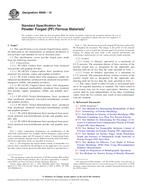Potrebujeme váš súhlas na využitie jednotlivých dát, aby sa vám okrem iného mohli ukazovať informácie týkajúce sa vašich záujmov. Súhlas udelíte kliknutím na tlačidlo „OK“.
ASTM D6682-08
Standard Test Method for Measuring Shear Stresses of Powders Using Peschl Rotational Split Level Shear Tester (Withdrawn 2017)
Automaticky preložený názov:
Štandardná skúšobná metóda pre meranie šmykové napätia práškov Použitie Peschl otáčania vstavaným podlažím nožnice Tester
NORMA vydaná dňa 1.10.2008
Informácie o norme:
Označenie normy: ASTM D6682-08
Poznámka: NEPLATNÁ
Dátum vydania normy: 1.10.2008
Kód tovaru: NS-36131
Počet strán: 14
Približná hmotnosť: 42 g (0.09 libier)
Krajina: Americká technická norma
Kategória: Technické normy ASTM
Kategórie - podobné normy:
Anotácia textu normy ASTM D6682-08 :
Keywords:
bulk density, bulk solids, cohesive strength, degradation, flowability, internal friction, Peschl shear tester, rotational shear tester, shear stress, wall friction, Bulk density, Cohesive strength, Degradation--environmental materials/applications, Internal friction testing, Peschl shear tester, Powders, Shear stress, Shear testing--soil, Wall friction, ICS Number Code 77.160 (Powder metallurgy)
Doplňujúce informácie
| Significance and Use | ||||||
|
The test method is useful for the following: Classification of Powders—The cohesion and angle of internal friction are flowability indicators of powders and can be used to classify the powders. Quality Control—For a number of industrial applications flowability factors are used to compare the material flowability at different times during production. The material produced has to be held within given limits for each application and each powder so as to ensure trouble-free operation. Material Engineering—Powder properties are influenced by particle size, particle size distribution, fat content, humidity and other parameters. By selecting the correct parameters and the correct mixtures of powders, the required mechanical properties of the product are achieved. Design of Handling Equipment—For certain storage and conveyor equipment mathematical models exist which require the mechanical properties of powders. Note 2—The quality of the result produced by this standard is dependent on the competence of personnel performing it, and the suitability of the equipment and facilities used. Agencies that meet the criteria of Practice D 3740 are generally considered capable of competent and objective testing/sampling/inspection/etc. Users of this standard are cautioned that compliance with Practice D 3740 does not in itself assure reliable results. Reliable results depend on many factors; Practice D 3740 provides a means of evaluating some of those factors. Practice D 3740 was developed for agencies engaged in the testing or inspection (or both) of soil and rock. As such it is not totally applicable to agencies performing this standard. However, users of this standard should recognize that the framework of Practice D 3740 is appropriate for evaluating the quality of an agency performing this standard. Currently there is no known qualifying national authority that inspects agencies that perform this standard. |
||||||
| 1. Scope | ||||||
|
1.1 This test method is applied to the measurement of the mechanical properties of powders as a function of normal stress. 1.2 This apparatus is suitable measuring the properties of powders and other bulk solids, up to a particle size of 5000 micron. 1.3 This method comprises four different test procedures for the determination of powder mechanical properties: 1.3.1 Test A—Measurement of INTERNAL FRICTION as a function of normal stress. 1.3.2 Test B—Measurement of WALL FRICTION as a function of normal stress. 1.3.3 Test C—Measurement of BULK DENSITY as a function of normal stress and time. 1.3.4 Test D—Measurement of DEGRADATION as a function of normal stress. 1.4 All observed and calculated values shall conform to the guidelines for significant digits and rounding established in Practice D 6026. 1.4.1 The procedures used to specify how data are collected/recorded or calculated in this standard are regarded as the industry standard. In addition, they are representative of the significant digits that generally should be retained. The procedures used do not consider material variation, purpose for obtaining the data, special purpose studies, or any considerations for the user’s objectives, and it is common practice to increase or reduce significant digits of reported data to be commensurate with these considerations. It is beyond the scope of this standard to consider significant digits used in analysis methods for engineering design. 1.5 The values stated in SI units are to be regarded as standard. No other units of measurement are included in this standard. 1.6 This standard does not purport to address all of the safety concerns, if any, associated with its use. It is the responsibility of the user of this standard to establish appropriate safety and health practices and determine the applicability of regulatory limitations prior to use. |
||||||
| 2. Referenced Documents | ||||||
|
Podobné normy:
Historická
1.12.2010
Historická
15.11.2012
Historická
1.10.2013
Historická
1.12.2010
Historická
15.5.2012
Historická
1.5.2010
Odporúčame:
Aktualizácia technických noriem
Chcete mať istotu, že používate len platné technické normy?
Ponúkame Vám riešenie, ktoré Vám zaistí mesačný prehľad o aktuálnosti noriem, ktoré používate.
Chcete vedieť viac informácií ? Pozrite sa na túto stránku.



 ASTM B848-10
ASTM B848-10 ASTM B853-12
ASTM B853-12 ASTM B859-13
ASTM B859-13 ASTM B883-10e1
ASTM B883-10e1 ASTM B887-12
ASTM B887-12 ASTM B895-05(2010)e1..
ASTM B895-05(2010)e1..
 Cookies
Cookies
